The Ansys RF Channel Modeler™ plugin is installed separately from the base installation of the Ansys Systems Tool Kit® (STK®) application. The optimal location to try out the RF Channel Modeler plugin is through the AGI Digital Engineering (DE) Lab. If you are a current AGI or Ansys customer, please reach out to your account manager to request a DE Lab account for access to the tools needed to work through this tutorial. If you are a student or educator at an academic institution enrolled in the Ansys Academic program, please reach out to your Ansys Support Coordinator to request the same.
Pictures, graphs, and data snippets are used as examples only. The results of the tutorial may vary depending on the user settings and data enabled (online operations, dynamic Earth data, etc.). It is acceptable to have different results.
Capabilities covered
This lesson covers the following capabilities of the Ansys Systems Tool Kit® (STK®) digital mission engineering software:
- STK Communications (especially the RF Channel Modeler plugin)
Problem statement
You want to determine the signal connection performance of a base station and its antenna system for a wireless network. You have to account for antenna capability, obscurations, moving transceivers, and signal reflections. You want to see how this base station performs when communicating with a mobile transceiver in the presence of a scene contributor, all against the backdrop of buildings and terrain. This exercise gives you the basic capability to then launch your own further study of varying aspects such as base location, transceiver setup, antenna parameters, scene contributors, etc. The cost is high if you try this using real antennas in real scenes, so you need to simulate this instead.
Solution
You can use the STK software to model all the objects, facets, and antenna placements in your analysis region. You can then employ the RF Channel Modeler plugin inside of the STK application to design analysis configurations that include analysis extents, antenna types, waveform settings, transceivers, scene contributors, and reflectance materials. Running each analysis configuration produces an HDF5 file that contains high-fidelity scattering parameter antenna-to-antenna coupling data for all of your analysis configurations. By looking at different types of plots of the data, you can determine the performance of each configuration.
Ultimately, you could enhance this exercise to place your base station at different feasible locations and run more RF Channel Modeler analysis configurations. This would help you to find the optimum location for your base station in that area. For this tutorial, you will just look at one base station location.
For more information on setting up analysis configurations, see the RF Channel Modeler Help.
You can run the RF Channel Modeler plugin through the RFCM API. For a description of available sample code, see the RF Channel Modeler section of the Plugin Samples topic page in the STK Programming Help. If you execute the RF Channel Modeler plugin through the Object Model, you must set the following system environment variables:
ANSYSCL252_DIR: Set this to the licensing client directory in your install directory at <Install Dir>\licensingclient.
ANSYSLIC_DIR: Set this to the licensing folder located in your install directory at <Install Dir>\Shared Files\Licensing.
What you will learn
Upon completion of this tutorial, you will be able to:
- Create a basic STK scenario for a wireless network.
- Load in a facets tileset.
- Set up RF Channel Modeler analysis configurations, including the specification of analysis extents, antenna types, waveform settings, transceivers, scene contributors, and reflectance materials.
- Produce several views of the results of the RF Channel Modeler analysis runs and see the effects of main antenna and reflected beam interactions.
Learning the STK application
If you are new to the STK application, consider first walking through the following Level 1 STK tutorials to become familiar with the basic functionality of the STK application needed for setting up scenarios for the RF Channel Modeler plugin.
Level 1, Part 1: Build Scenarios
Level 1, Part 2: Objects and Properties
Verifying the RF Channel Modeler plugin is installed
Ensure that the RF Channel Modeler plugin is installed on your computer.
- Open the STK application (
 ). In the initial dialog box, the RF Channel Modeler plugin should be in the list under "Additional Capabilities".
). In the initial dialog box, the RF Channel Modeler plugin should be in the list under "Additional Capabilities". - Select the check box next to RF Channel Modeler before continuing. Doing so ensures that the plugin is available within the STK application.
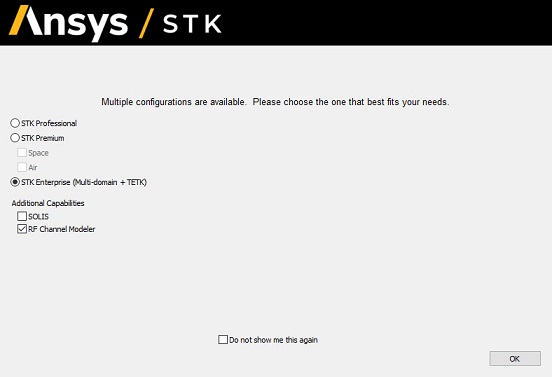
See the next section for how to proceed in the STK application.
Creating a new scenario
You must create an STK scenario. Then you can set up your RF Channel Modeler analyses. You already launched the STK application and should now see the Welcome to STK dialog box.
- Click .
- Enter "RFCM" as the Name in the STK: New Scenario Wizard and leave everything else as the default values.
- Click when you finish.
- Click Save (
 ) after the scenario loads. The STK application creates a folder with the same name as your scenario.
) after the scenario loads. The STK application creates a folder with the same name as your scenario. - Verify the scenario name and location in the Save As dialog box.
- Click .
Save (![]() ) the scenario after each section of this tutorial!
) the scenario after each section of this tutorial!
Enabling your GPU in the STK application UI
To run an RF Channel Modeler analysis, you need to let the STK application know the Graphics Processing Units (GPUs) that you have available on your computer to use. You must have at least one available and registered in the STK application.
- Go to the Edit menu in the STK application and select Preferences.
- Go to the RF Channel Modeler page.
- Make sure at least one Enabled check box is selected next to an available GPU on the GPU Properties pane.
- Click to accept any changes and close the Preferences dialog box.
Setting up the scenario
You will want to use epoch seconds as the time units for your scenario, since you want to generate results that start at time 0.0 seconds. This makes it easier for selecting times to view plots.
- Double-click the RFCM scenario object in the Object Browser to bring up its Properties Browser.
- Go to the Basic - Units page.
- Select DateFormat under Dimension.
- Under Current Unit, click the box next to DateFormat.
- Use the drop-down menu to select Epoch Seconds (EpSec) as the units.
- Click to save this change and close the Properties Browser.
- Close the 2D Graphics window. You will not need this.
- Click the deletion "X" near the bottom of the STK application UI to delete the Timeline View section. You will not need this either, and deleting it creates more room for viewing the RF Channel Modeler plugin UI later.
Adding a facet tileset to the STK
You need to add a facet tileset to STK that at least covers the area of your analyses. This tileset provides 3D modeling of known stationary structures and terrain in the covered area.
- Go to the 3D Graphics window.
- Click the Globe manager icon (
 ) in the toolbar.
) in the toolbar. - Make sure you are in the Hierarchy tab in the Globe Manager window.
- Click the Add Terrain/Imagery icon (
 ).
). - Select Add 3D Tilesets.
- Select the check box next to the AGI_Headquarters tileset.
- Click .
- Click in the Use Tileset for Analysis dialog box.
- Close the Globe Manager window.
Inserting a Place object
For your analyses, you want to have a network base station transceiver. Create a Place object to anchor the location of the base station transceiver.
- Click the Insert Object icon (
 ).
). - Select Place (
 ) on the left and Define Properties (
) on the left and Define Properties ( ) on the right.
) on the right. - Click . You should see the Basic - Position page of the Place1 properties.
- Change the following property values:
- Select the Use terrain data check box.
- Click to apply and close the properties.
| Property | Value |
|---|---|
| Latitude | 40.0389 deg |
| Longitude | -75.5963 deg |
| Height Above Ground | 0.02 km |
You now have a base at about 65 feet above the terrain.
Inserting a Sensor object for Place1
Add a sensor and attach it to Place1. You must have a Sensor object in the STK application as the host for any transceiver in the RF Channel Modeler plugin.
- Click the Insert Object icon (
 ).
). - Select to insert a Sensor (
 ) object using the Define Properties (
) object using the Define Properties ( ) method.
) method. - Click .
- Attach the sensor to Place1 in the Select Object dialog box.
- Click . The Basic - Definition page of the Sensor1 properties should appear.
- Set Cone Half Angle to 10 degrees.
- Go to the Basic - Pointing page.
- Set Azimuth to 0 degrees and Elevation to 90 degrees, so the sensor is pointing directly up.
- Click to apply and close the properties.
Inserting a Ground Vehicle object
You will add a moving transceiver to your analyses. Create a Ground Vehicle object to carry the transceiver and generate the motion using four waypoints that define the span of the analysis interval.
- Click the Insert Object icon (
 ).
). - Select to insert a Ground Vehicle (
 ) object using the Define Properties (
) object using the Define Properties ( ) method.
) method. - Click . The Basic - Route page of the GroundVehicle1 properties should appear.
Creating waypoints
Someone is driving GroundVehicle1 (![]() ) near Place1 (
) near Place1 (![]() ). You can define its course using the Basic - Route properties page. You will assign four waypoints, specifying latitude, longitude, and altitude for each. You do not need to set Speed, Accel, Time, or Turn Radius; just accept the default values for these.
). You can define its course using the Basic - Route properties page. You will assign four waypoints, specifying latitude, longitude, and altitude for each. You do not need to set Speed, Accel, Time, or Turn Radius; just accept the default values for these.
- Click on the Basic - Route page of GroundVehicle1's properties.
- Set the following for the first waypoint:
- Click .
- Set the following for the second waypoint:
- Click .
- Set the following for the third waypoint:
- Click .
- Set the following for the fourth waypoint:
- Set Reference to Terrain in the Altitude Reference section of the page.
- Click to accept all changes and close the GroundVehicle1 Properties Browser.
| Option | Value |
|---|---|
| Latitude | 40.03822 deg |
| Longitude | -75.59748 deg |
| Altitude | 0.00675 km |
| Option | Value |
|---|---|
| Latitude | 40.0392 deg |
| Longitude | -75.5982 deg |
| Altitude | 0.00597 km |
| Option | Value |
|---|---|
| Latitude | 40.03976 deg |
| Longitude | -75.5968 deg |
| Altitude | 0.00599 km |
| Option | Value |
|---|---|
| Latitude | 40.03857 deg |
| Longitude | -75.59596 deg |
| Altitude | 0.00823 km |
Keep in mind that the center point of the ground vehicle is right on top of the terrain. The object center point, unless changed, is where analysis for the object takes place. Also, terrain undulation could be a factor. The ground vehicle could appear, visually, to dart into and out of terrain, especially when modeling in an area containing rugged terrain. Terrain resolution can be a factor too.
All ground object center points start on the terrain surface.
Inserting a Sensor object for GroundVehicle1
Add a sensor and attach it to GroundVehicle1. This serves as the host for the mobile transceiver.
- Click the Insert Object icon (
 ).
). - Select to insert a Sensor (
 ) object using the Define Properties (
) object using the Define Properties ( ) method.
) method. - Click .
- Attach the sensor to GroundVehicle1 in the Select Object dialog box.
- Click . The Basic - Definition page of the Sensor2 properties should appear.
- Set Cone Half Angle to 45 degrees.
- Go to the Basic - Pointing page.
- Set Azimuth to 0 degrees and Elevation to 90 degrees.
- Click to apply and close the properties.
Creating a Facility object as a scene contributor
Create a facility of sufficient size to use as an RF Channel Modeler scene contributor that will tangibly influence analysis results. In the 3D Graphics window, the facility will look like a cube.
- Click the Insert Object icon (
 ).
). - Select Facility (
 ) on the left and Define Properties (
) on the left and Define Properties ( ) on the right.
) on the right. - Click . You should see the Basic - Position page of the Facility1 properties.
- Change the following property values:
- Select the Use terrain data check box, if not already selected.
- Go to the 3D Graphics - Model page.
- Click the ellipsis (
 ) next to Model File and browse to and select the Cube.glb file in your install folder at C:\Program Files\AGI\STK_ODTK 13\Data\Resources\stktraining\samples. This is a cube-shaped building model.
) next to Model File and browse to and select the Cube.glb file in your install folder at C:\Program Files\AGI\STK_ODTK 13\Data\Resources\stktraining\samples. This is a cube-shaped building model. - Click to apply and close the properties.
- Click Facility1 in the STK Object Browser, right-click, and select Zoom To. In the 3D Graphics window, you can see that Facility1 is very close to Place1, your base station. Ground Vehicle1 will pass between Place1 and Facility1 near the end of its route.
| Property | Value |
|---|---|
| Latitude | 40.0395 deg |
| Longitude | -75.5963 deg |
| Height Above Ground | 0 km |
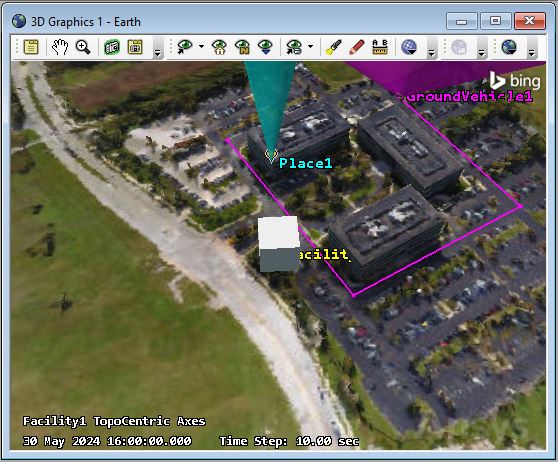
Opening the RF Channel Modeler plugin
You are now ready to use the RF Channel Modeler plugin to analyze your scenario.
- Click the Utilities menu in the STK application.
- Select RF Channel Modeler - Configuration. The RF Channel Modeler plugin UI will appear.
You will work in this plugin UI for the remainder of the tutorial.
Adding transceivers
Under the Design tab of the RF Channel Modeler plugin UI, you will now add transceivers to both sensors in the STK scenario. The transceivers will not appear as STK objects in the STK Object Browser. For each transceiver, you will specify (or accept default) parameters for the transceiver antenna, waveform, and the STK 3D Graphics window display.
Make sure you are working in the Design tab of the RF Channel Modeler plugin UI before proceeding. The Design tab should list the Place, Ground Vehicle, and Sensor objects in the Object Browser of the STK application.
Adding a transceiver to Sensor1 on Place1
- Expand (
 ) Place1 in the Design tab.
) Place1 in the Design tab. - Select Sensor1 and click the down arrow next the Add Transceiver icon (
 ) to select Communications type. This creates a Communications transceiver (
) to select Communications type. This creates a Communications transceiver ( ) called Sensor1_TxRx.
) called Sensor1_TxRx. - Click in the Add Communications Transceiver dialog box that appears.
- Expand (
 ) Sensor1_TxRx, if necessary, and select Antenna.
) Sensor1_TxRx, if necessary, and select Antenna. - Set the following Antenna parameters:
- Select Waveform and apply the following parameter values:
- Select Graphics and apply the following parameter values:
- Click at the bottom of the RF Channel Modeler plugin UI to apply the changes.
| Parameter | Value |
|---|---|
| Antenna Type | Far Field Data Pattern |
| HFSS Element Export Pattern File | Click and choose "3.5GHz_DipoleV.ffd" in your install folder at C:\Program Files\AGI\STK_ODTK 13\Data\Resources\stktraining\samples. |
| Parameter | Value |
|---|---|
| RF Channel Frequency (GHz) | 3.5 |
| Channel Bandwidth (MHz) | 100 |
| Frequency Samples / Sounding | 512 |
| Sounding Interval (msec) | 20 |
| Soundings / Analysis Time Step | 10 |
| Complete Simulation Interval (msec) | Read only |
| Unambiguous Channel Delay (msec) | Read only |
| Unambiguous Channel Distance (m) | Read only |
| Parameter | Value |
|---|---|
| Enable | Select this check box. |
| Max Radius (m) | 5 |
| Display Range (dB) | Select the Auto check box. |
Adding a transceiver to Sensor2 on GroundVehicle1
- Expand (
 ) GroundVehicle1 and Sensor2 in the Design tab.
) GroundVehicle1 and Sensor2 in the Design tab. - Select Sensor2 and click the down arrow next the Add Transceiver icon (
 ) to select Communications type. This creates a Communications transceiver (
) to select Communications type. This creates a Communications transceiver ( ) called Sensor2_TxRx.
) called Sensor2_TxRx. - Click in the Add Communications Transceiver dialog box that appears.
- Expand (
 ) Sensor2_TxRx and select Antenna.
) Sensor2_TxRx and select Antenna. - Set the following Antenna parameters:
- Select Waveform and apply the following parameter values:
- Select Graphics and apply the following parameter values:
- Click at the bottom.
| Parameter | Value |
|---|---|
| Antenna Type | Far Field Data Pattern |
| HFSS Element Export Pattern File | Click and choose "3.5GHz_DipoleV.ffd" in your install folder at C:\Program Files\AGI\STK_ODTK 13\Data\Resources\stktraining\samples. |
| Parameter | Value |
|---|---|
| RF Channel Frequency (GHz) | 3.5 |
| Channel Bandwidth (MHz) | 100 |
| Frequency Samples / Sounding | 512 |
| Sounding Interval (msec) | 20 |
| Soundings / Analysis Time Step | 10 |
| Complete Simulation Interval (msec) | Read only |
| Unambiguous Channel Delay (msec) | Read only |
| Unambiguous Channel Distance (m) | Read only |
| Parameter | Value |
|---|---|
| Enable | Select this check box. |
| Max Radius (m) | 5 |
| Display Range (dB) | Select the Auto check box. |
Your Design tab should look like this:
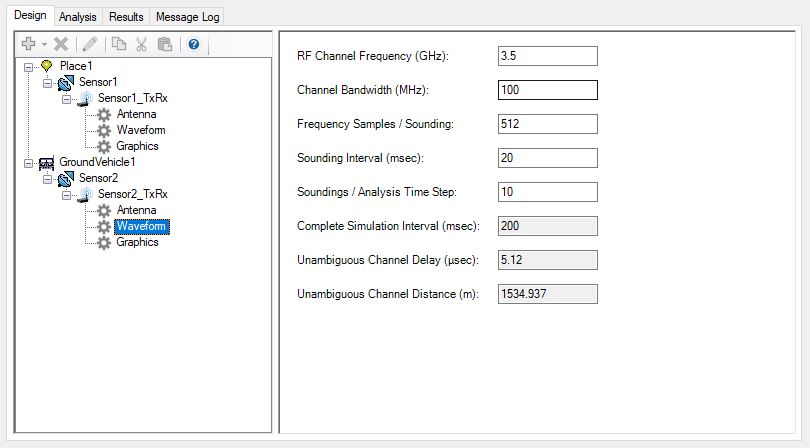
Creating analysis configurations
In the Analysis tab in the RF Channel Modeler plugin, you can create analysis configurations and apply whichever transceivers you wish from the ones you created under the Design tab. You need to add a facet tileset to each analysis configuration. You can add scene contributors from the list of qualifying objects in the STK Object Browser. Adding a scene contributor places a custom item in the analysis that can cause signal reflections, in addition to the reflections from existing objects and terrain in the facets tileset. The RF Channel Modeler plugin will check to assure that any scene contributor object you select has an associated model that provides suface facets, otherwise the analysis configuration will not be available to run. The Analysis tab also enables you to specify analysis compute times and designate the results file mode and output folder path. You can then run an analysis configuration from the Analysis tab.
For this section, make sure you are in the Analysis tab of the RF Channel Modeler plugin. You will create two analysis configurations by setting up one and then copying and modifying the copy to generate a second.
Creating an analysis configuration
Create an analysis configuration, which you will specify in the following sections.
- Click the down arrow next to the Add Analysis Configuration icon (
 ) at the upper-left corner of the Analysis tab.
) at the upper-left corner of the Analysis tab. - Select the Communications option. The Add Communications Configuration dialog box appears.
- Enter the name "Mobile_Only" in the Add Communications Configuration dialog box.
- Click .
- Click at the bottom.
You now have an analysis configuration available to set up and compute. For Mobile_Only, you will not add any scene contributors.
Choosing transceivers for the analysis configuration
For Mobile_Only, choose the transceivers on Place1 and GroundVehicle1.
- Select Mobile_Only at the top of the Analysis tab.
- Click the Add Transceiver Configuration icon (
 ) in the Transceivers subtab below. The Add Communications Analysis Configuration Transceivers dialog box will appear.
) in the Transceivers subtab below. The Add Communications Analysis Configuration Transceivers dialog box will appear. - Select the Select check boxes for the following transceivers in the Add Analysis Configuration Transceivers dialog box:
- Sensor1_TxRx
- Sensor2_TxRx
- Click .
- Set the Mode to TransmitOnly for Sensor1_TxRx.
- Set the Mode to ReceiveOnly for Sensor2_TxRx.
- Click at the bottom.
Setting the analysis compute times
Enter specific start and stop times for your analysis. Although the STK scenario covers an entire day, you want to greatly reduce the actual analysis time span due to the significant amount of time it takes to process even a minute or two of a configuration. Since GroundVehicle1 is part of the analysis configuration and only has waypoints to cover about 15.2 seconds of scenario time, the analysis would stop after 15+ seconds. However, you should set the analysis time to make sure that alterations to the configuration do not lengthen the analysis computation time to excessive durations.
You can see the duration of waypoint availability by opening the properties of GroundVehicle1 in the STK Object Browser and looking at the Basic - Route page. For the last waypoint, the Time value will show how long the vehicle took to go from the starting waypoint to that ending waypoint.
- Select Mobile_Only at the top of the Analysis tab.
- Go to the Analysis Compute Times subtab.
- Clear the Use Scenario Analysis Interval check box, if necessary.
- Enter 0.000 (EpSec) for Start Time.
- Enter 16.000 (EpSec) for Stop Time.
- Select the Continuous Channel Soundings radio button, if not already selected.
- Click at the bottom.
Choosing a facet tileset
Apply the AGI_Headquarters facet tileset to this analysis configuration.
- Select Mobile_Only at the top of the Analysis tab.
- Go to the Facet Tileset subtab.
- Click . The Add Facet Tileset dialog box will appear.
- Select the Select check box for the AGI_Headquarters tileset.
- Click to apply your selection and close the dialog box.
- Click the drop-down arrow under Material and select Asphalt. This is a realistic tileset material designation for the tileset.
- Click at the bottom.
Setting analysis extents
Use the Analysis Extent Tool to create a bounded area inside the AGI-Headquarters facet tileset region. The tool enables you to set the latitude and longitude boundaries of your analysis.
When you run your analysis, the solver will only consider objects (stationary and moving) within the extents you set here, not all objects in the entire facet tileset region. Making a smaller analysis area saves processing time but may exclude some signal reflections.
- Select Mobile_Only at the top of the Analysis tab.
- Make sure you are still in the Facet Tileset subtab.
- Click .
- Enter the following values in the Analysis Extent Tool dialog box:
- Click to save the values and close the dialog box.
- Select the Show Extent check box in the Analysis Extent Graphics pane. Keep the default settings for the other parameters.
- Click at the bottom of the RF Channel Modeler plugin window.
- Minimize the RF Channel Modeler window and look at your 3D Graphics window in STK. You should be able to see the extents box inside of the tileset. The box should enclose the vehicle path, buildings, facility, and most of the parking area.
| Extent parameter | Value |
|---|---|
| North Latitude (deg) | 40.04013 |
| West Longitude (deg) | -75.59884 |
| South Latitude (deg) | 40.03788 |
| East Longitude (deg) | -75.59514 |
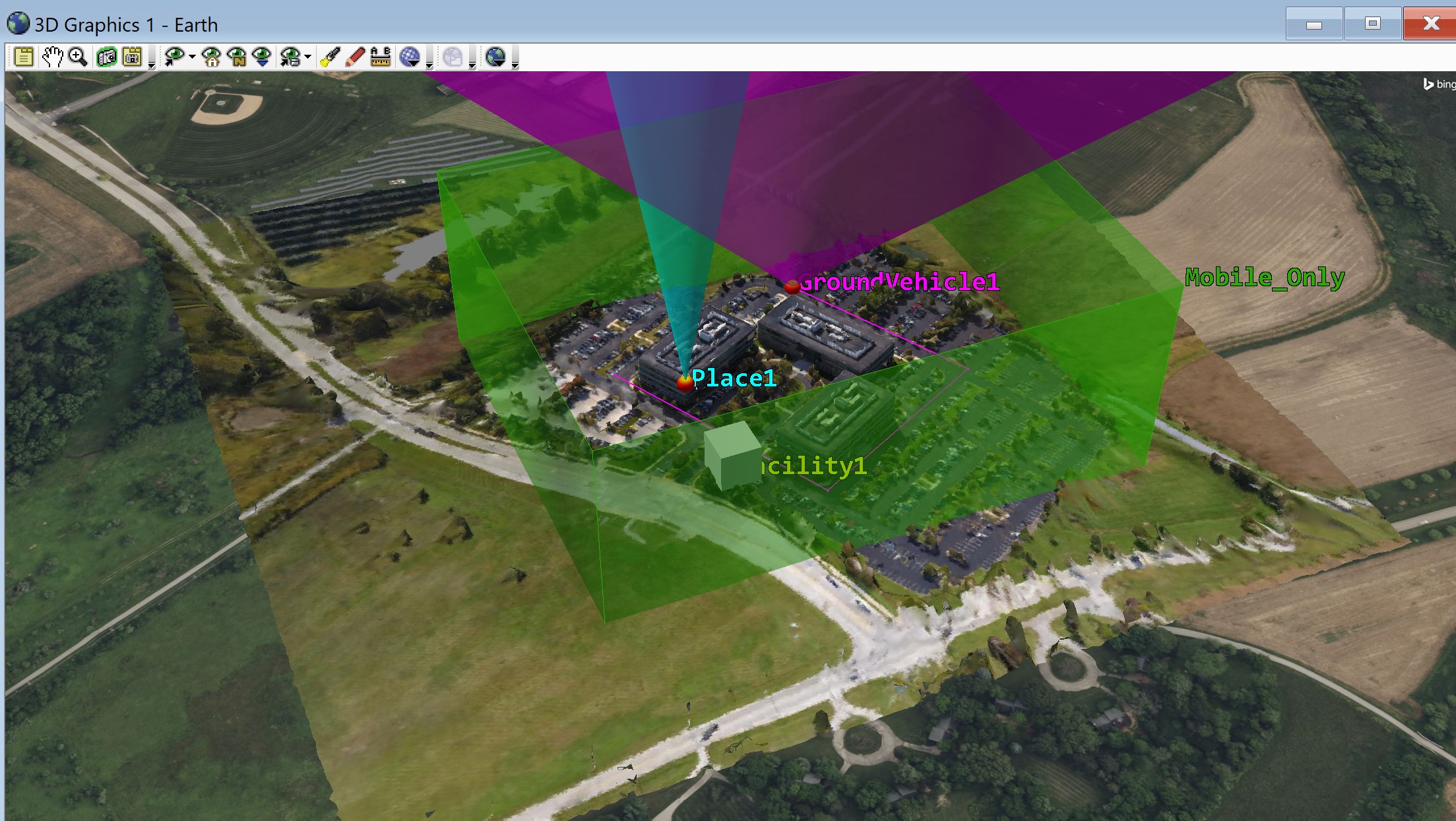
You can also access the Analysis Extent Tool by clicking its icon (![]() ) at the top of the Analysis tab.
) at the top of the Analysis tab.
Setting the results output
Set the results file mode and the output folder.
- Go to the Results Output subtab.
- Click at the bottom of the Analysis Description pane.
- Write the following sentence in the Analysis Description box: "Configuration 1: Vehicle 1 is moving in the area of the AGI Headquarters in the presence of the Place1 transceiver. There are no scene contributors."
- Click to close the Analysis Description dialog box.
- Set Results File Mode to Single file if not already set.
- Look at the bottom of the Analysis tab and make note of the default results folder that the RF Channel modeler will create for you when you start generating output.
- Click at the bottom of the RF Channel Modeler plugin window.
Look near the top of the RF Channel Modeler window. Your Mobile_Only analysis configuration should have a status of "Ready to run."
Creating a second analysis configuration
You will create a second analysis configuration by copying the first. This second configuration will be the same as the first, with the difference being the addition of Facility1 as a scene contributor.
- Select Mobile_Only at the top of the Analysis tab.
- Click the Duplicate Configuration icon (
 ).
). - Enter "Mobile_and_Facility" as the Name in the Duplicate Configurations Analysis dialog box.
- Click to close the dialog box.
- Click at the bottom of the RF Channel Modeler plugin window.
Adding a scene contributor to Mobile_and_Facility
For the Mobile_and_Facility analysis configuration, you will add Facility1 as a scene contributor.
- Select the Mobile_and_Facility analysis configuration at the top of the Analysis tab.
- Go to the Scene Contributor Objects subtab.
- Click the Add Scene Contributor icon (
 ).
). - Select the Select check box for Facility1 in the Add Analysis Configuration Scene Contributors dialog box.
- Click .
- Make sure "Metal" is the material named in the Material column.

- Click at the bottom of the RF Channel Modeler plugin window.
Adjusting the description for Mobile_and_Facility
- Click the Results Output subtab.
- Click .
- Change the Analysis Description box entry to the following: "Configuration 2: Vehicle 1 is moving in the area of AGI Headquarters in the presence of the Place1 transceiver. Facility 1 is a scene contributor with metal construction."
- Click to close the Analysis Description dialog box.
- Click at the bottom of the RF Channel Modeler plugin window.
Generating results
Run both analysis configurations to see the resulting data for the 16-second interval.
- Select Mobile_Only at the top of the Analysis tab.
- Click at the bottom of the Analysis tab.
- Repeat steps 1-2 for Mobile_and_Facility.
The results are now in the output folder.

Viewing results from analysis runs
The Results tab enables you to filter for specific data and view different plot types within the analysis runs you already generated. Based on your selection of Analysis (analysis configuration), Results (time stamp), and Link (transceiver connection), the Summary section provides a read-only view of key parameter values. You can use the Plotting Parameters section to choose the plot type and its accompanying parameter values.
After you generate the plot, the right side of the Results tab shows the specific plot. You can then alter the display view (lines, colors, symbols, zoom, etc.), and you have other options available such as save, copy, print, etc.
Plotting Response vs Frequency from the Mobile_Only run results
Generate and view a Response vs Frequency plot of the data from running Mobile_Only.
- Select the Results tab at the top of the RF Channel Modeler plugin UI.
- Select the Use analysis output folder as results folder check box, if not already selected, near the top of the Results tab. This tells the RF Channel Modeler to automatically point to the output folder specified in the Analysis tab.
- Select Mobile_Only for Analysis in the Results Filter section.
- There should be only one choice for Results.
- For Link, select Place1-Sensor1-Sensor1_TxRx_to_GroundVehicle1-Sensor2-Sensor2_TxRx.
- Set the following under Plotting Parameters:
- Click .
| Extent parameter | Value |
|---|---|
| Plot Type | Response vs Frequency |
| Transmit Antenna Index | 0 |
| Receive Antenna Index | 0 |
| Channel Sounding Index | 0 |
| Time Sample (EpSec) | 4 |
Viewing the plot display
You can see your selected plot of data on the right. Try out some different ways to view the data.
- Click the Display Plot Data icon (
 ) at the top to show a split screen of the plot and the underlying data. This toggle is not available for waterfall plots because the amount of data is too great.
) at the top to show a split screen of the plot and the underlying data. This toggle is not available for waterfall plots because the amount of data is too great. - Click again to see just the plot.
- Right-click the plot and try out the different line, color, symbol, grid, and legend settings.
- Scroll the middle button of your mouse forward to zoom in and out on the plot.
- Choose an area to zoom in on by holding the left mouse button down and dragging a box around the area to highlight. You should see a closer view of just the boxed area.
- Go back to the original plot by right-clicking and selecting Undo Zoom.
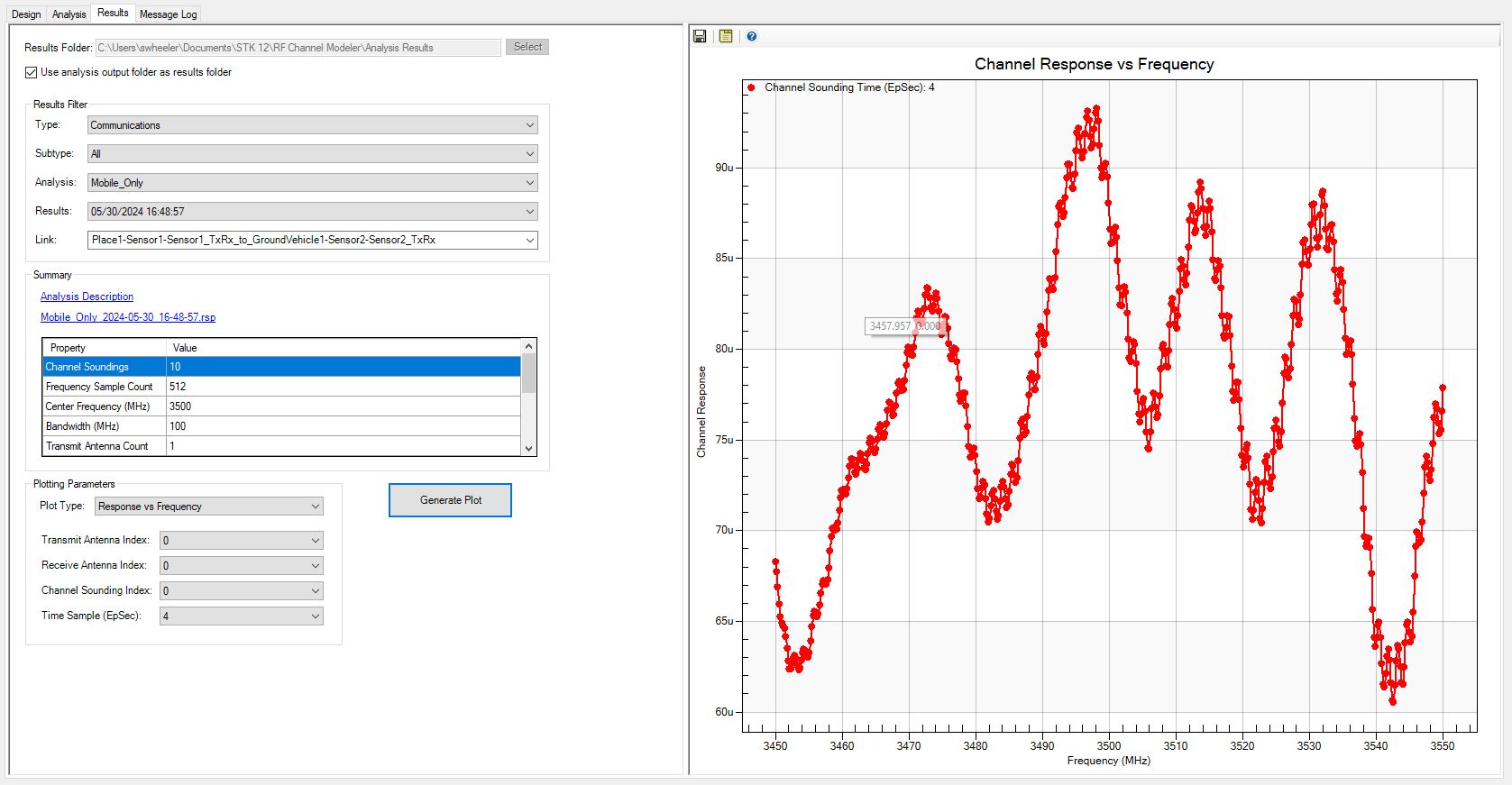
Viewing the Time vs Frequency Waterfall plot for Mobile_Only
Plots like "Response vs Frequency" and "Response vs Time" give insight for a specific time and frequency, respectively. However, you want to get a broader picture of what is happening in the scenario over the whole time period for a range of frequencies. For this broader view, use waterfall plots. The first one to try is Time vs Frequency Waterfall.
- Set the following under Plotting Parameters:
- Click .
- You will see that, except for a few specific times, the signal strength is weak across all frequencies for the first 11 seconds or so, which is the lower three-fourths of the plot. This is because the buildings are generally blocking the direct line of sight from the Place antenna to the Ground Vehicle antenna. When the Ground Vehicle is in view, the signal strength goes up, as expected.
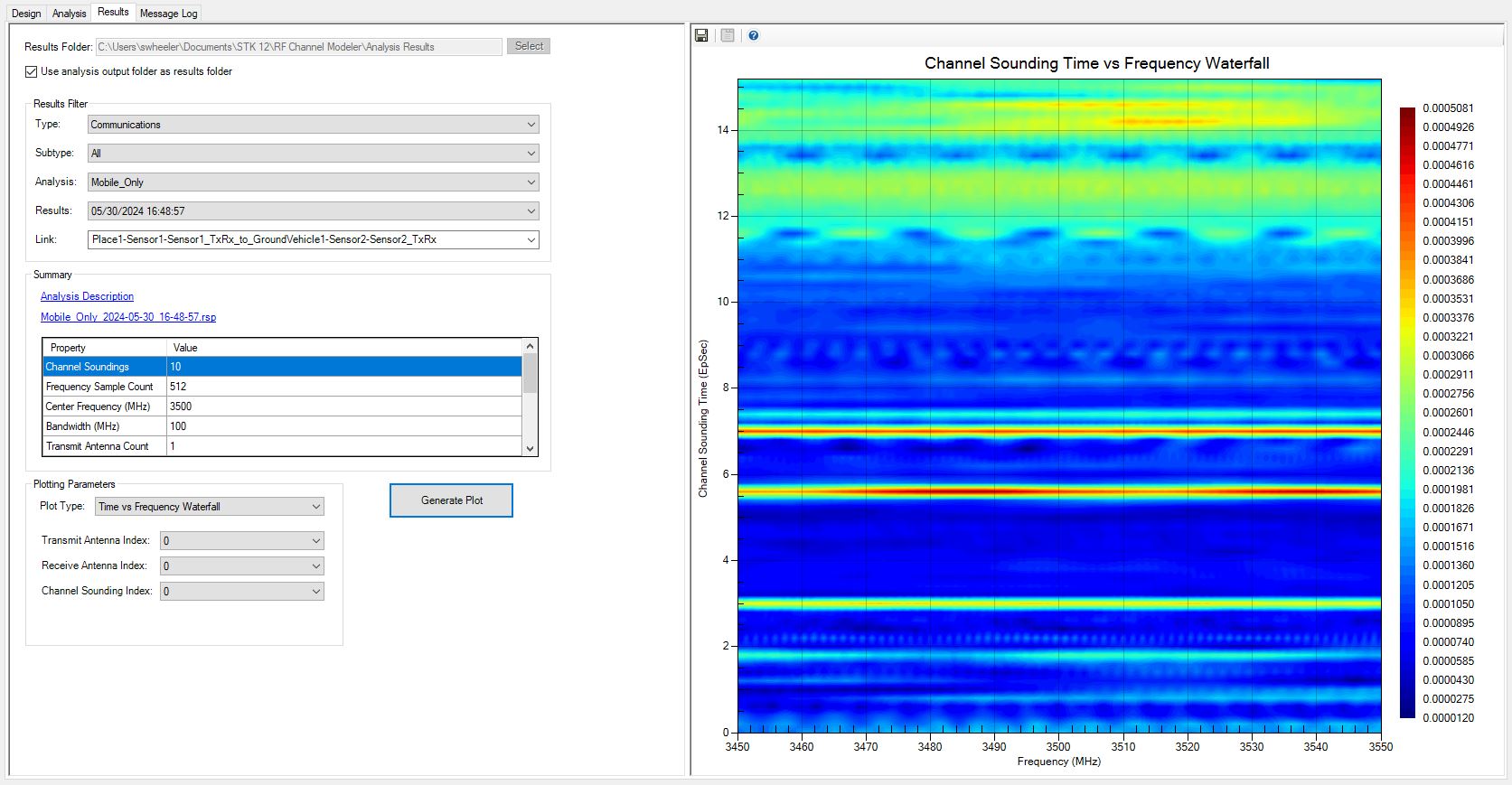
- Place your cursor over the plot and right-click.
- Select Decibel from the shortcut list. This changes the plot to a decibel scale, as you can see in the legend on the right.
| Extent parameter | Value |
|---|---|
| Plot Type | Time vs Frequency Waterfall |
| Transmit Antenna Index | 0 |
| Receive Antenna Index | 0 |
| Channel Sounding Index | 0 |
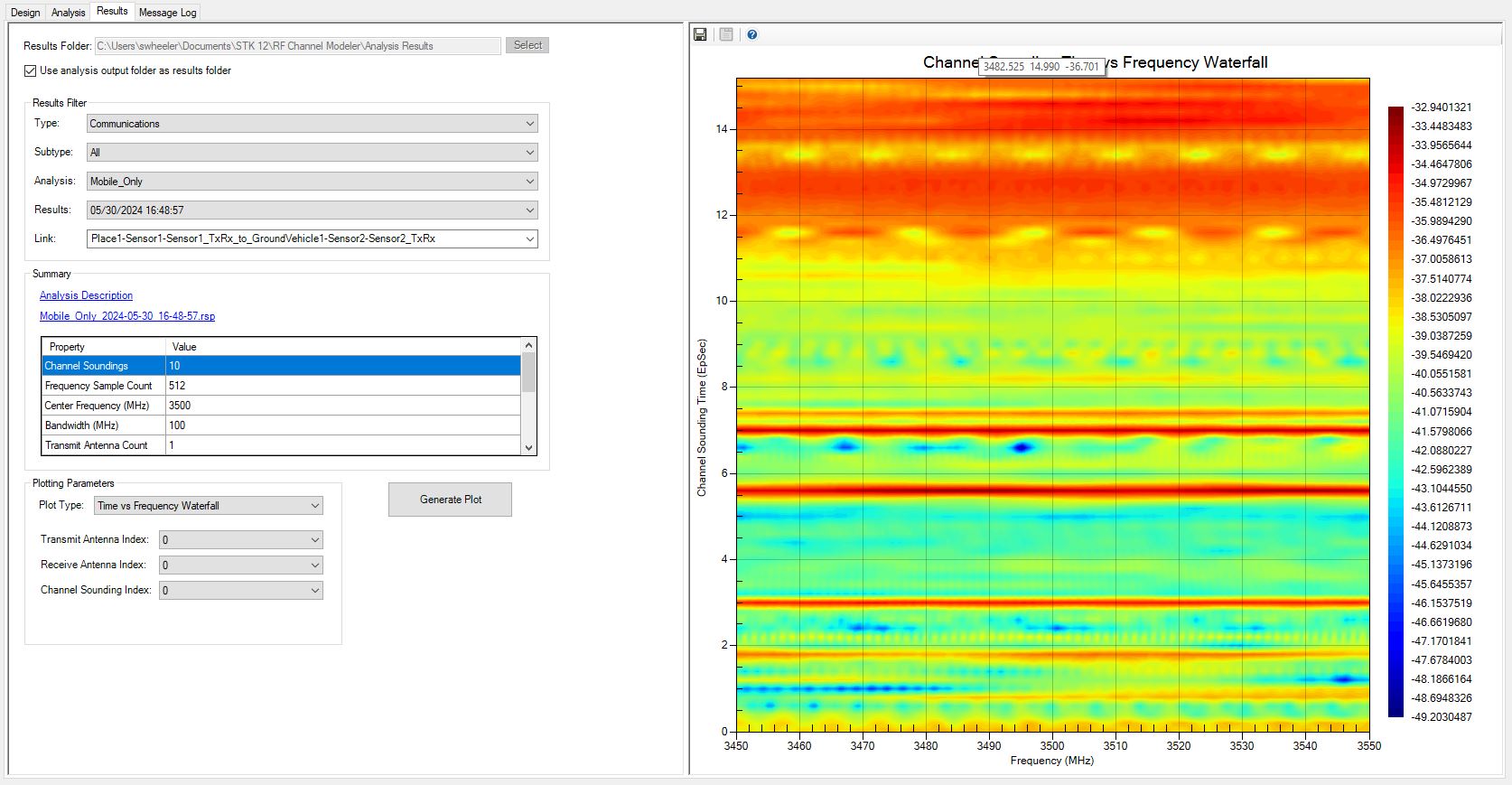
Viewing the Time vs Signal Distance-of-Flight Waterfall plot for Mobile_Only
Now try the Time vs Signal Distance-of-Flight Waterfall plot. This shows the distance traveled by the signal, revealing the direct connection between the Place antenna and the Ground Vehicle antenna as well as the reflected signals.
- Set the following under Plotting Parameters:
- Click . The plot will be in Decibel scale, since you did not change that setting.
- The signals of interest are all on the left quarter of the plot, so try to enlarge that area. Click and hold a point on the plot just in the upper-left corner, and then drag the cursor down and to the right to cover just the areas that have some contrast, at about 400 m. When you let go of the left-click button, the plot will refocus to just the area that you outlined.
| Extent parameter | Value |
|---|---|
| Plot Type | Time vs Signal Distance-of-Flight Waterfall |
| Transmit Antenna Index | 0 |
| Receive Antenna Index | 0 |
| Channel Sounding Index | 0 |
You will see the main signal path. The two changes in trajectory at about 4.5 and 9.5 seconds represent the vehicle turning corners. After the second corner, the main signal forms essentially a parabolic path as the vehicle makes its closest approach to the Place antenna around the 12.5 second mark and then starts moving away. The lighter signals to the right of the main path represent reflections off of buildings and other tileset items.
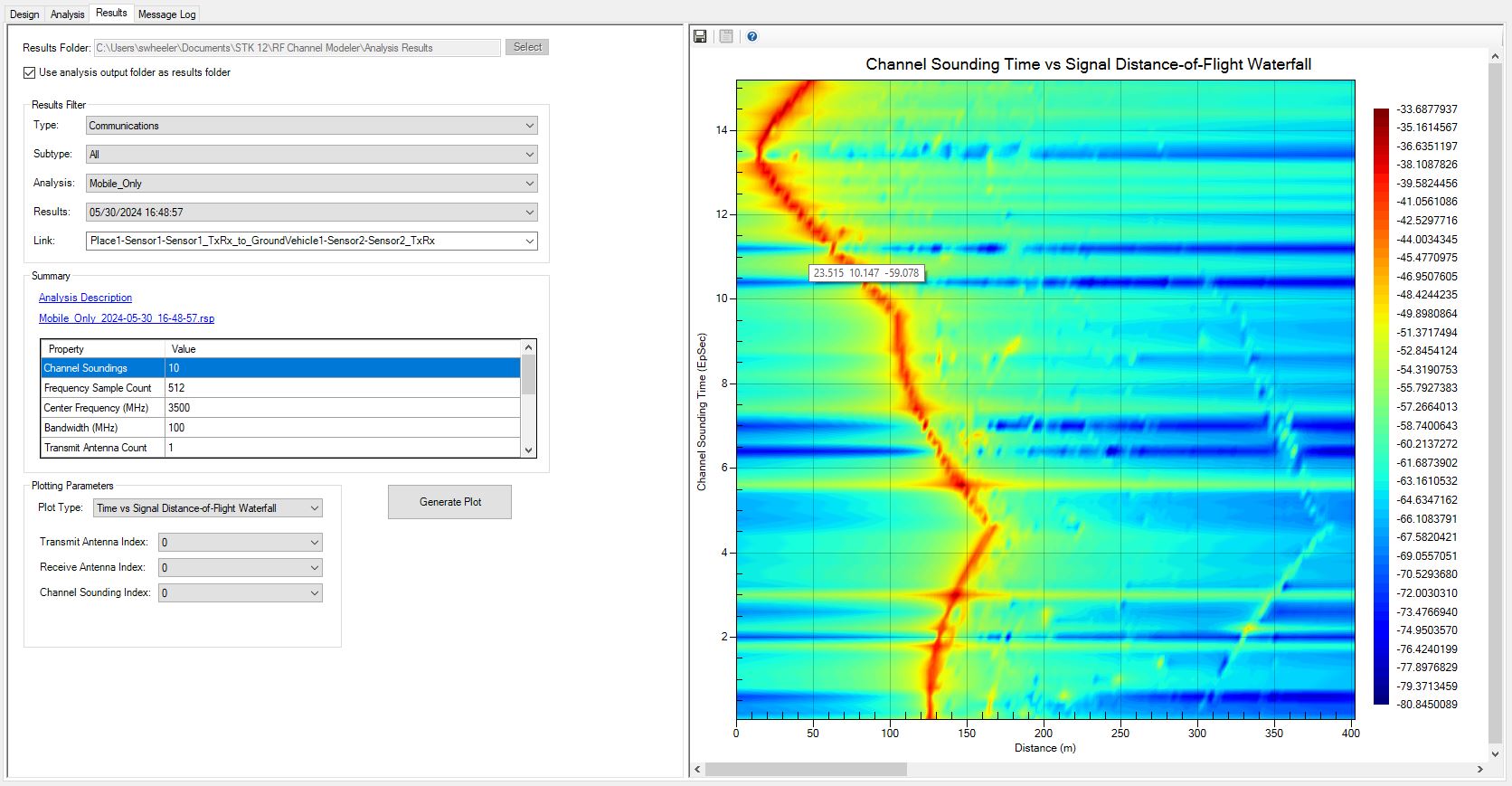
Viewing the results for Mobile_and_Facility
Now generate the results from the Mobile_and_Facility analysis configuration. This time, go directly to the Time vs Signal Distance-of-Flight Waterfall plot. You want to see the effect the scene contributor (Facility1) has on the results.
- Select the Use analysis output folder as results folder check box near the top of the Results tab.
- Select Mobile_and_Facility for Analysis in the Results Filter section.
- There should be only one choice for Results.
- For Link, select Place1-Sensor1-Sensor1_TxRx_to_GroundVehicle1-Sensor2-Sensor2_TxRx.
- Set the following under Plotting Parameters:
- Click .
- The signals of interest are all on the left quarter of the plot, so try to enlarge that area. Click and hold a point on the plot just in the upper-left corner, and then drag the cursor down and to the right to cover just the areas that have some contrast, at about 400 m. When you let go of the left-click button, the plot will refocus to just the area that you outlined.
| Extent parameter | Value |
|---|---|
| Plot Type | Time vs Signal Distance-of-Flight Waterfall |
| Transmit Antenna Index | 0 |
| Receive Antenna Index | 0 |
| Channel Sounding Index | 0 |
Again, you see the main signal path on the plot. However, this time the reflected signals to the right of the main signal path are different, particularly in the last few seconds (at the top). The vehicle is directly between the Place antenna and the Facility scene contributor at about 13.5 EpSec. Starting at about 12 EpSec, you can see a secondary line starting at the 70 m mark and slanting up and right. This is a secondary signal from the Facility (scene contributor) that was not present in the Time vs Signal Distance of Flight waterfall plot for Mobile_Only.

Changing the scene contributor shape
You can use a different model (building shape) for Facility1 and see what the impact is on your results.
- Highlight Facility1 in the STK Object Browser and click the Properties icon (
 ).
). - Go to the 3D Graphics - Model page.
- Click the ellipsis (
 ) for Model File.
) for Model File. - Go to C:\Program Files\AGI\STK_ODTK 13\STKData\VO\Models\Land and choose the facility.glb file. In the 3D Graphics window, you can see that this facility model is shaped like a golf ball.
- Click to apply the changes and close the Properties Browser.
- Go back to the RF Channel Modeler Analysis tab and rerun the Mobile_and_Facility analysis configuration.
- Go to the Results tab.
- Select the latest Mobile_and_Facility results.
- Click for Plot Type = Time vs Signal Distance-of-Flight Waterfall.
Notice that the secondary signal line coming from the Facility1 scene contributor is weaker and more spread out because the amount of reflectance off the ball shape is lower and more scattered than the reflectance off the side of the cube.
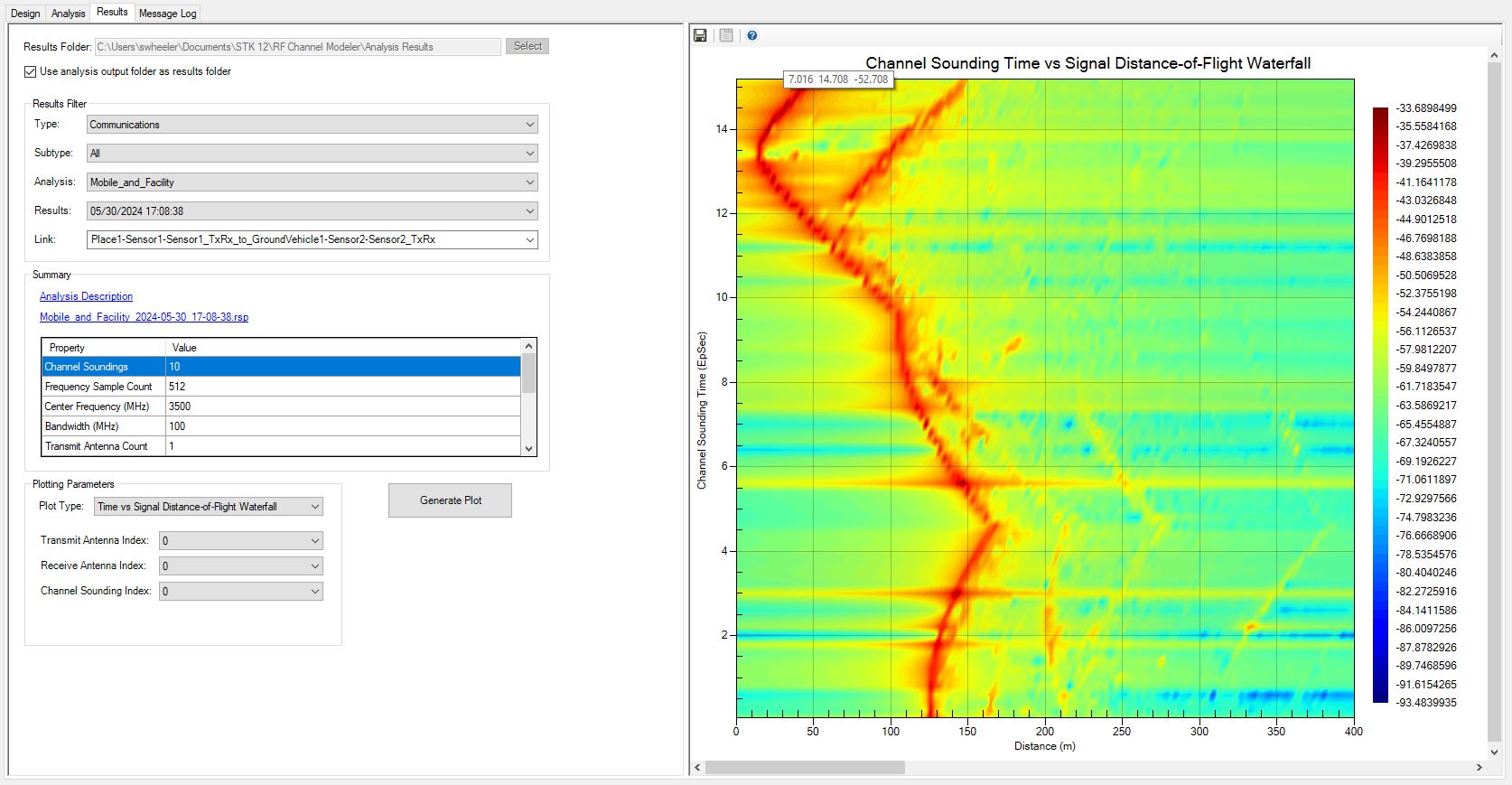
Saving your work
- Close the RF Channel Modeler plugin UI.
- Save (
 ) your work.
) your work.
Summary
In this exercise, you learned how to use the STK application and the RF Channel Modeler plugin to do the following:
- Place a base station, model a moving object, and create a stationary facility in the STK application
- Place sensor objects on STK objects
- Use the RF Channel Modeler plugin to add transceivers to sensor objects and apply specific antenna types, waveforms, and graphics properties to the transceivers
- Designate transceivers for analysis configurations
- Include local structures, terrain, and scene contributors in the analysis
- Specify analysis extents
- Generate different plot types to visualize your results data
You saw that a scene contributor can significantly affect your results.
On your own
In this lesson, you set up and ran two analysis configurations, with the only variation being a scene contributor. Take the time to explore possible variations by changing the antenna placements and types, the waveform settings, and the scene contributor objects and characteristics.
You can also explore using the STK Connect commanding capability to perform both the STK scenario setup and the RF Channel Modeler analysis configuring and execution. To do this, you should first complete the STK general tutorial on Connect commanding:
Level 1, Part 5: Introduction to Connect
This will help you on your way toward building the STK scenario. You can then set up and run RF Channel Modeler analysis configurations, perform the runs, and retrieve the results. Use the following Help pages to guide your building of the RF Channel Modeler commanding:
RfChannelModeler - These are the basic commands for setting up and running analysis configurations.
RfChannelModeler_RM - Use these commands to retrieve information from the RF Channel Modeler plugin.
RfChannelModelerGraphics - Use this command to set values for graphics quantities such as antenna boundaries and analysis extents.
RfChannelModelerGraphics_RM - Use this command to retrieve values for graphics attributes.